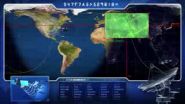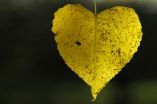(Press-News.org) For years, researchers have been interested in developing quantum computers—the theoretical next generation of technology that will outperform conventional computers. Instead of holding data in bits, the digital units used by computers today, quantum computers store information in units called "qubits." One approach for computing with qubits relies on the creation of two single photons that interfere with one another in a device called a waveguide. Results from a recent applied science study at Caltech support the idea that waveguides coupled with another quantum particle—the surface plasmon—could also become an important piece of the quantum computing puzzle.
The work was published in the print version of the journal Nature Photonics the week of March 31.
As their name suggests, surface plasmons exist on a surface—in this case the surface of a metal, at the point where the metal meets the air. Metals are conductive materials, which means that electrons within the metal are free to move around. On the surface of the metal, these free electrons move together, in a collective motion, creating waves of electrons. Plasmons—the quantum particles of these coordinated waves—are akin to photons, the quantum particles of light (and all other forms of electromagnetic radiation).
"If you imagine the surface of a metal is like a sea of electrons, then surface plasmons are the ripples or waves on this sea," says graduate student Jim Fakonas, first author on the study.
These waves are especially interesting because they oscillate at optical frequencies. Therefore, if you shine a light at the metal surface, you can launch one of these plasmon waves, pushing the ripples of electrons across the surface of the metal. Because these plasmons directly couple with light, researchers have used them in photovoltaic cells and other applications for solar energy. In the future, they may also hold promise for applications in quantum computing.
However, the plasmon's odd behavior, which falls somewhere between that of an electron and that of a photon, makes it difficult to characterize. "According to quantum theory, it should be possible to analyze these plasmonic waves using quantum mechanics"—the physics that governs the behavior of matter and light at the atomic and subatomic scale—"in the same way that we can use it to study electromagnetic waves, like light," Fakonas says. However, in the past, researchers were lacking the experimental evidence to support this theory.
To find that evidence, Fakonas and his colleagues in the laboratory of Harry Atwater, Howard Hughes Professor of Applied Physics and Materials Science, looked at one particular phenomenon observed of photons—quantum interference—to see if plasmons also exhibit this effect.
The applied scientists borrowed their experimental technique from a classic test of quantum interference in which two single, identical photons are launched at one another through opposite sides of a 50/50 beam splitter, a device that acts as an imperfect mirror, reflecting half of the light that reaches its surface while allowing the the other half of the light to pass through. If quantum interference is observed, both identical photons must emerge together on the same side of the beam splitter, with their presence confirmed by photon detectors on both sides of the mirror.
Since plasmons are not exactly like photons, they cannot be used in mirrored optical beam splitters. Therefore, to test for quantum interference in plasmons, Fakonas and his colleagues made two waveguide paths for the plasmons on the surface of a tiny silicon chip. Because plasmons are very lossy—that is, easily absorbed into materials that surround them—the path is kept short, contained within a 10-micron-square chip, which reduces absorption along the way.
The waveguides, which together form a device called a directional coupler, act as a functional equivalent to a 50/50 beam splitter, directing the paths of the two plasmons to interfere with one another. The plasmons can exit the waveguides at one of two output paths that are each observed by a detector; if both plasmons exit the directional coupler together—meaning that quantum interference is observed—the pair of plasmons will only set off one of the two detectors.
Indeed, the experiment confirmed that two indistinguishable photons can be converted into two indistinguishable surface plasmons that, like photons, display quantum interference.
This finding could be important for the development of quantum computing, says Atwater. "Remarkably, plasmons are coherent enough to exhibit quantum interference in waveguides," he says. "These plasmon waveguides can be integrated in compact chip-based devices and circuits, which may one day enable computation and measurement schemes based on quantum interference."
Before this experiment, some researchers wondered if the photon–metal interaction necessary to create a surface plasmon would prevent the plasmons from exhibiting quantum interference. "Our experiment shows this is not a concern," Fakonas says.
"We learned something new about the quantum mechanics of surface plasmons. The main thing is that we were able to validate the theoretical prediction; we showed that this type of interference is possible with plasmons, and we did a pretty clean measurement," he says. "The quantum interference displayed by plasmons appeared to be almost identical to that of photons, so I think it would be very difficult for someone to design a different structure that would improve upon this result."
INFORMATION:
The work was published in a paper titled "Two-plasmon quantum interference." In addition to Fakonas and Atwater, the other coauthors are Caltech undergraduate Hyunseok Lee and former undergraduate Yousif A. Kelaita (BS '12). The work was supported by funding from the Air Force Office of Scientific Research, and the waveguide was fabricated at the Kavli Nanoscience Institute at Caltech.
Quantum photon properties revealed in another particle -- the plasmon
2014-04-03
ELSE PRESS RELEASES FROM THIS DATE:
NIST launches a new US time standard: NIST-F2 atomic clock
2014-04-03
The U.S. Department of Commerce's National Institute of Standards and Technology (NIST) has officially launched a new atomic clock, called NIST-F2, to serve as a new U.S. civilian time and frequency standard, along with the current NIST-F1 standard.
NIST-F2 would neither gain nor lose one second in about 300 million years, making it about three times as accurate as NIST-F1, which has served as the standard since 1999. Both clocks use a "fountain" of cesium atoms to determine the exact length of a second.
NIST scientists recently reported the first official performance ...
Taming a poison: Saving plants from cyanide with carbon dioxide
2014-04-03
The scientific world is one step closer to understanding how nature uses carbon-capture to tame poisons, thanks to a recent discovery of cyanoformate by researchers at Saint Mary's University (Halifax, Canada) and the University of Jyväskylä (Finland). This simple ion — which is formed when cyanide bonds to carbon dioxide — is a by-product of the fruit-ripening process that has evaded detection for decades.
Chemists have long understood the roles presence of cyanide (CN−) and carbon dioxide (CO2) in fruit ripening, but have always observed them independently. This ...
Hot mantle drives elevation, volcanism along mid-ocean ridges
2014-04-03
PROVIDENCE, R.I. [Brown University] — Scientists have shown that temperature differences deep within Earth's mantle control the elevation and volcanic activity along mid-ocean ridges, the colossal mountain ranges that line the ocean floor. The findings, published April 4 in the journal Science, shed new light on how temperature in the depths of the mantle influences the contours of the Earth's crust.
Mid-ocean ridges form at the boundaries between tectonic plates, circling the globe like seams on a baseball. As the plates move apart, magma from deep within the Earth rises ...
HIV vaccine research must consider various immune responses
2014-04-03
WHAT:Last year, the National Institute of Allergy and Infectious Diseases (NIAID), part of the National Institutes of Health, held a scientific meeting to examine why certain investigational HIV vaccines may have increased susceptibility to HIV infection. In a new perspectives article appearing in the journal Science, HIV research leaders from NIAID (Anthony S. Fauci, M.D., and Carl W. Dieffenbach, Ph.D.) and its grantees at Emory University (Eric Hunter, Ph.D.) and the University of California, San Francisco (Susan Buchbinder, M.D.), summarize the findings and considerations ...
Moving the fence posts
2014-04-03
The use of fenced areas to protect threatened species in the wild should be a last resort, argue scientists from the Zoological Society of London (ZSL) and the Wildlife Conservation Society (WCS).
In an article published in the journal Science, the authors state that there is a need to review the use of fencing as the conservation community develops a clearer understanding of the ecological changes caused when an area is fenced.
Fencing can have a disruptive impact on predator-prey dynamics, with species such as the African wild dog learning to chase prey into fences. ...
Researchers design trees that make it easier to produce paper
2014-04-03
Researchers have genetically engineered trees that will be easier to break down to produce paper and biofuel, a breakthrough that will mean using fewer chemicals, less energy and creating fewer environmental pollutants.
"One of the largest impediments for the pulp and paper industry as well as the emerging biofuel industry is a polymer found in wood known as lignin," says Shawn Mansfield, a professor of Wood Science at the University of British Columbia.
Lignin makes up a substantial portion of the cell wall of most plants and is a processing impediment for pulp, ...
Cassini reports sub-surface ocean on Enceladus
2014-04-03
Enceladus—one of Saturn's smaller satellites—has joined the ranks of Titan and Europa as a moon that appears to have liquid water splashing around inside of it, researchers say. New gravity data from the Cassini spacecraft, which has been exploring the planet's moons for 10 years, reveal that Enceladus harbors an ocean of water beneath 18 to 24 miles (30 to 40 kilometers) of ice at its surface.
A team of Italian and American scientists led by Luciano Iess at Sapienza Università di Roma in Rome, Italy investigated the moon's gravity field and the notable asymmetry it ...
Gravity measurements confirm subsurface ocean on Enceladus
2014-04-03
In 2005, NASA's Cassini spacecraft sent pictures back to Earth depicting an icy Saturnian moon spewing water vapor and ice from fractures, known as "tiger stripes," in its frozen surface. It was big news that tiny Enceladus—a mere 500 kilometers in diameter—was such an active place. Since then, scientists have hypothesized that a large reservoir of water lies beneath that icy surface, possibly fueling the plumes. Now, using gravity measurements collected by Cassini, scientists have confirmed that Enceladus does in fact harbor a large subsurface ocean near its south pole, ...
'Unzipping' poplars' biofuel potential
2014-04-03
EAST LANSING, Mich. — What began 20 years ago as an innovation to improve paper industry processes and dairy forage digestibility may now open the door to a much more energy- and cost-efficient way to convert biomass into fuel.
The research, which appears in the current issue of Science, focuses on enhancing poplar trees so they can break down easier and thus improving their viability as a biofuel. The long-term efforts and teamwork involved to find this solution can be described as a rare, top-down approach to engineering plants for digestibility, said Curtis Wilkerson, ...
Study shows more than half of high-risk alcohol users report improvement after surgery
2014-04-03
BOSTON – Much has been reported about the potential for increased risk of alcohol misuse after weight loss surgery (WLS), with most theories pointing to lower alcohol tolerance and a longer time to return to a sober state after surgery, but a new study from Beth Israel Deaconess Medical Center suggests that upwards of half of high-risk drinkers are actually less likely to report high-risk drinking behavior after weight loss surgery.
The results appear in the journal, Surgery for Obesity and Related Diseases.
"This is the first study to show that high-risk drinking ...


